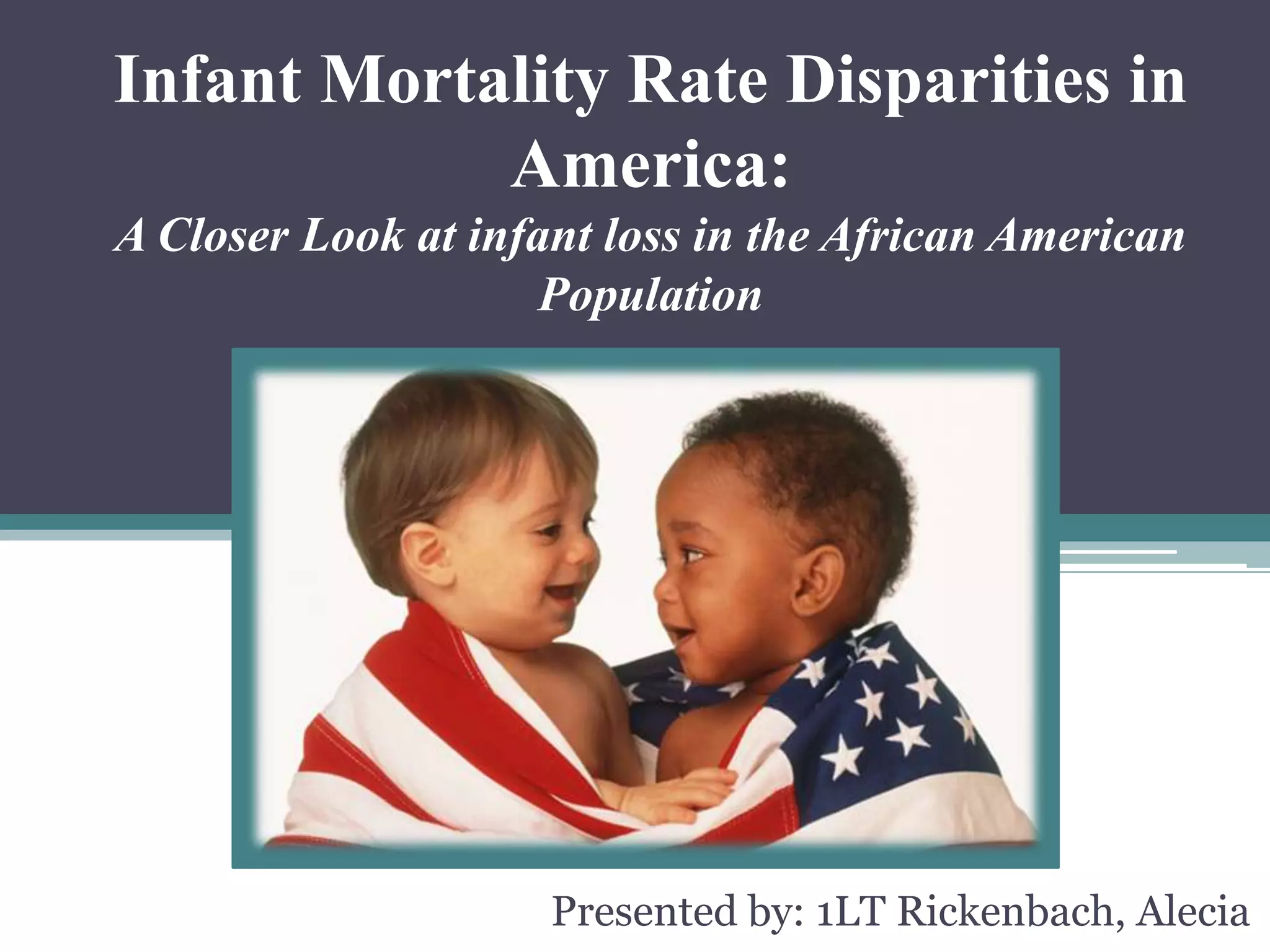Infant Mortality Disparities: Exploring Racial Differences

Infant mortality disparities represent a significant and pressing issue in the landscape of American healthcare, where Black infant mortality remains acutely higher than white infant mortality. Recent studies reveal that despite overall improvements in life expectancy for both Black and white Americans, the gap in infant mortality rates has widened alarmingly. In fact, Black infants are now dying at rates that are twice that of their white counterparts, highlighting deep-rooted healthcare inequality. This disparity underscores the urgent need to understand the factors influencing mortality rates, particularly among vulnerable populations. Addressing these disparities is not just a healthcare imperative but a moral obligation to ensure that every child, regardless of race, has a fair and equitable start in life.
The critical divide in infant survivability rates among racial groups casts a long shadow over America’s healthcare system, illustrating a troubling pattern of inequity. As discussions about mortality outcomes advance, it’s essential to address the heightened risk faced by Black infants compared to their white peers. The widening gap in mortality rates calls attention to the structural healthcare disparities that persist within the society. A comprehensive review of these disparities reveals that they involve multifaceted issues, including access to quality medical care and underlying social determinants of health. It’s crucial for public health policies to evolve and prioritize the reduction of these mortality rates, ensuring every infant has the opportunity for a healthy start.
Understanding Infant Mortality Disparities
Infant mortality disparities represent a significant public health issue in the United States, particularly concerning racial groups. Recent data reveals a troubling trend in which Black infants continue to experience mortality rates more than double that of white infants. This stark contrast highlights a gap that has not only persisted but has worsened over the decades. Despite advances in healthcare improving life expectancy for adults, similar benefits have not translated to the most vulnerable population—infants. Understanding the root causes of these disparities is critical, as it reflects broader issues of healthcare inequality and systemic biases in access and quality of care.
The historical context is essential in addressing these disparities. The study published by researchers at Harvard covers a 70-year period from 1950 to 2019, revealing that while life expectancy has improved significantly for both Black and white populations, the rates of infant mortality tell a different story. Medical conditions during pregnancy, compounded by socioeconomic factors and inadequate healthcare access, have been identified as leading causes of death among Black infants. As policymakers and healthcare providers consider solutions, it is essential to understand that without a focus on these disparities, progress in overall healthcare will continue to leave some populations behind.
The Role of Healthcare Inequality
Healthcare inequality is a multifaceted issue that affects various demographic groups, particularly racial minorities. The disparities in infant mortality rates serve as a glaring indicator of deeper systemic failures within the healthcare system. Factors such as lack of access to prenatal care, inadequate health education for expectant mothers, and the persistent challenges of poverty disproportionately affect Black communities. Furthermore, the quality of care received often varies significantly based on race, leading to unequal health outcomes. Recognizing and addressing these healthcare inequalities is imperative to improving the overall health of Black infants and closing the mortality gap.
Moreover, accentuating the importance of equitable access to healthcare cannot be overstated. The studies indicate that if Black Americans had access to the same quality and range of healthcare services as their white counterparts, millions of lives could have been saved over the past seven decades. This reality underscores the argument for systemic reforms in healthcare policy that aim to dismantle barriers and address the root causes of this inequality. Public health interventions must be directed at improving prenatal and postnatal care, ensuring that healthcare providers are equipped with the resources and knowledge to care for all patients equally.
Long-Term Trends in Mortality Rates
The long-term trends in mortality rates reveal a complex narrative of progress and regression. While the overall mortality rates for adults have narrowed significantly between Black and white Americans, the situation for infants presents a stark contrast. The data indicates that the gap in infant mortality rates has grown, with Black infants facing higher risks than ever before. This troubling trend raises questions about the effectiveness of health reforms and societal approaches in addressing racial disparities within our healthcare system. It challenges us to rethink how we measure success in improving health outcomes across demographics.
Additionally, analyzing mortality rates over a long period allows for a more comprehensive understanding of the shifts in public health outcomes. The Harvard study’s insights provide critical data on how ostensibly improving healthcare metrics can mask ongoing disparities, especially in infant health outcomes. A longitudinal approach emphasizes the need for sustained commitment to addressing these disparities rather than superficial improvements that fail to account for the complexity of the issues at hand. Moving forward, it is crucial for public health officials to frame infant mortality not only as an individual health issue but also as a community-wide challenge that requires collective action.
Identifying Causes of Excess Infant Mortality
Identifying the causes of excess infant mortality rates between Black and white populations remains a crucial focal point of research and policy. Medical conditions during pregnancy play a significant role in infant health outcomes, yet these issues cannot be viewed in isolation. Factors such as maternal health, socio-economic status, and access to comprehensive prenatal care must all be considered in the broader scope of infant mortality disparities. By understanding the interconnectedness of these factors, stakeholders can design more effective interventions aimed at reducing these grim statistics.
Moreover, further investigation into the social determinants of health is crucial for uncovering the underlying issues contributing to higher mortality rates among Black infants. Researchers and public health officials must delve into the specifics of healthcare access, quality, and the socioeconomic conditions that prevail in communities disproportionately affected by high infant mortality rates. Ultimately, enhancing our understanding of these causes is essential in crafting targeted policies that can lead to tangible improvements in outcomes for Black infants.
Implications for Public Policy and Health Authorities
The implications of the recent findings surrounding infant mortality disparities extend far beyond the realm of healthcare; they raise essential questions for public policy and community advocacy. If the aim is to effectively close the gap in mortality rates, targeted approaches must be prioritized. Health authorities need to recognize that policies must not merely aim to improve healthcare for all but also actively address inequalities that disproportionately affect Black families. This necessitates a concerted effort towards ensuring equal healthcare access, education, and outreach to vulnerable communities.
Initiating systemic changes within public health frameworks is fundamental to reversing the trends in infant mortality rates. Such changes could include enhanced funding for maternal health programs specifically aimed at Black mothers, increased training for healthcare practitioners on cultural competence, and the establishment of community support systems that prioritize prenatal and postnatal care. By aligning public policies with the realities faced by underserved communities, health authorities can embark on a pathway towards achieving equity in infant health outcomes.
The Call for Comprehensive Research
The call for comprehensive research into the persistent disparities in infant mortality is an urgent one. Previous studies have made important contributions, but the findings from the Harvard team provide a long-range view that is unprecedented. This type of comprehensive analysis not only highlights the need for ongoing research but also sets the foundation for targeted studies that can unravel the multifaceted causes of these disparities. By examining long-term data, researchers can identify trends and patterns that shorter studies might overlook.
Additionally, focusing on the gaps identified in the data can guide future research funding and policy decisions. The findings indicate that millions of lives could have been saved with better healthcare access; hence, future studies should aim to pinpoint specific barriers to care that exist within communities. Collaboration between academic institutions, public health authorities, and community organizations can bolster the data collection efforts needed to address and ultimately reduce these disparities.
Raising Awareness and Advocacy Strategies
Raising awareness about infant mortality disparities among different racial groups is crucial for fostering a collective response to this ongoing crisis. Advocacy efforts must aim at informing the public and policymakers about the stark realities faced by Black infants to garner the resources and attention necessary for impactful change. Media campaigns, grassroots organizations, and community leaders can play vital roles in amplifying the voices of those affected by these disparities, promoting education and mobilizing action.
Moreover, it is essential that advocacy strategies incorporate both quantitative data, such as mortality statistics, and personal narratives from affected families to generate a holistic understanding of the emotional and social dimensions of this issue. Engaging communities in dialogue around their experiences can help elucidate the human impact of healthcare inequality and drive home the urgency of implementing meaningful reforms. By building strong alliances and networks within and across communities, advocates can effectively influence public policy to prioritize reducing infant mortality disparities.
Community-Level Interventions
Community-level interventions are vital in addressing the dire disparities in infant mortality rates. These grassroots initiatives can create tailored programs that directly respond to the unique needs of the populations at risk. For example, establishing community health workers who can provide education, support, and resources for expectant mothers can have a profound impact on improving maternal and infant health outcomes. These individuals can bridge the gap between healthcare systems and families, ensuring that all mothers receive the care they need during and after pregnancy.
Innovative community health programs that focus on prenatal education, nutrition, and healthcare access can empower families to make informed choices that significantly reduce infant mortality rates. Comprehensive support systems, including home visits from health professionals and community education workshops, can foster healthier outcomes. Additionally, collaborating with local organizations to facilitate better access to necessary health services ensures that Black infants receive equitable care, which can ultimately help close the troubling mortality gaps.
The Future of Research and Policy Directions
The future of research on infant mortality disparities must address unanswered questions surrounding healthcare access and efficacy. As studies continue to reveal the persistent gaps in mortality rates, it becomes imperative for researchers to explore innovative solutions that not only pinpoint causes but also suggest actionable interventions. By leveraging technological advancements and data analytics, researchers can better understand the dynamics of health disparities, tailoring studies to reflect current health trends and challenges faced by communities.
Furthermore, policymakers must be keen to integrate research findings into actionable frameworks. There is an urgent need to align public health policies with the realities reflected by ongoing studies, focusing on closing the gap in infant mortality rates through responsive, community-driven strategies. Addressing disparities requires collaboration across sectors, ensuring that healthcare, education, and socio-economic initiatives are all working synergistically to provide a comprehensive approach to health equity. The future of health policy should prioritize the health of infants as a critical metric of societal wellbeing.
Frequently Asked Questions
What are the key factors contributing to Black infant mortality disparities compared to white infant mortality rates?
The Black infant mortality disparities are primarily attributed to healthcare inequality, including both access to and quality of care. Medical conditions during pregnancy and inadequate health resources are significant factors. Despite improvements in overall healthcare metrics in the U.S., the systemic issues leading to higher mortality rates among Black infants persist, highlighting urgent needs for policy reforms.
How have infant mortality rates changed over time between Black and white infants in the U.S.?
Infant mortality rates for both Black and white infants have improved over time; however, the disparity has worsened. Currently, Black infants die at rates that are twice as high as white infants, with the difference increasing from 92% in the 1950s to 115% today. This alarming trend emphasizes the need for targeted interventions to address the underlying causes of infant mortality disparities.
What implications does the widening gap in Black infant mortality have for public policy?
The widening gap in Black infant mortality rates indicates a pressing need for public policy reforms focused on healthcare equity. It suggests that existing policies have not sufficiently addressed the disparities, warranting urgent actions to improve access to quality healthcare for Black communities. Effective policy changes could potentially save millions of lives by ensuring equal healthcare resources and support.
What role does healthcare inequality play in the infant mortality disparities between racial groups?
Healthcare inequality plays a crucial role in infant mortality disparities between Black and white infants. Factors such as uneven access to prenatal care, differences in healthcare quality, and socioeconomic challenges contribute to this inequality. Addressing these disparities is vital for improving overall health outcomes and reducing the mortality rates of Black infants.
How can understanding the history of infant mortality disparities help address current healthcare issues?
Understanding the history of infant mortality disparities provides insight into the systemic issues and persistent inequalities in the healthcare system. By recognizing trends over the decades, policymakers and healthcare providers can develop informed strategies to combat these disparities and implement effective interventions that promote equity in health outcomes for all infants.
What steps can be taken to reduce Black infant mortality rates in the U.S.?
To reduce Black infant mortality rates, steps must include increasing access to quality prenatal and postnatal care, enhancing education on maternal health, and addressing the social determinants of health that disproportionately affect Black communities. Public health campaigns, improved healthcare policies, and community support programs are essential to tackle the root causes of infant mortality disparities.
| Key Points |
|---|
| Infant mortality rates among Black infants are double that of white infants, reflecting a significant disparity. |
| Over the past 70 years, life expectancy has improved for both Black (from 60.5 to 76 years) and white Americans (from 69 to 79.3 years), yet the gap in infant mortality rates has widened. |
| Despite improvements in healthcare, Black adults still face an 18% higher mortality rate than white adults. |
| The leading causes of infant mortality among Black infants are linked to medical conditions during pregnancy, highlighting healthcare inequalities. |
| The study analyzed data from 1950 to 2019, marking it as the first of its kind to encompass a comprehensive 70-year view. |
| Policymakers must focus on addressing and understanding the root causes of these disparities urgently. |
Summary
Infant mortality disparities remain a pressing issue in the United States, highlighting the significant gap in healthcare outcomes for Black infants compared to their white counterparts. Despite advancements in overall healthcare metrics, the mortality rate for Black infants continues to be alarmingly high. The findings from a 70-year study reveal that while life expectancy for both Black and white Americans has increased, the disparity in infant mortality has widened, with Black infants dying at twice the rate of white infants. This indicates an urgent need for targeted public health policies and interventions to address the healthcare inequalities contributing to these tragic outcomes.


